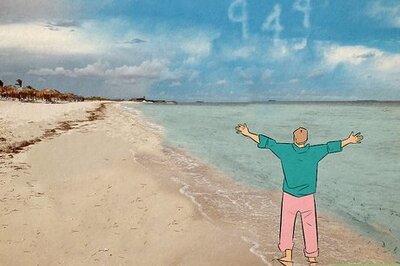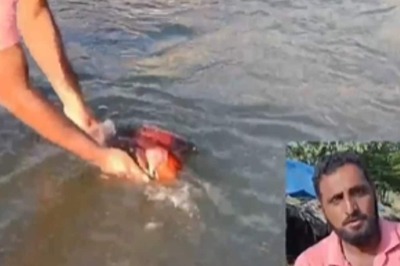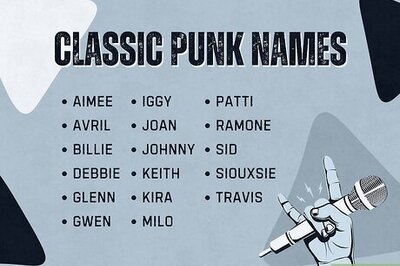
views
Sri Lanka’s economic crisis has finally toppled President Gotabaya Rajapaksa who plans to step down on July 13, bowing to intense pressure after violent protests in which demonstrators stormed the president’s official residence and set fire to the prime minister’s home in Colombo.
The violence and political chaos gripping the island nation of 22 million comes amid negotiations with the International Monetary Fund (IMF) over a rescue plan, as well as proposals to restructure its sovereign debt, both of which could be thrown into disarray. Short of cash to pay for imports of such necessities and already defaulting on its debt, Lanka is also seeking help from neighboring India and China.
The Island Nation emerged from a devastating civil war in 2009, only to be rocked by Islamist bombings in 2019, before being hit hard the following year by the Covid-19 pandemic which left the island bereft of tourists.
Here is a look back at how the crisis unfolded and what’s next for Sri Lanka.
Key Dates in Lankan Spiral
- April 1 | State of Emergency: Rajapaksa declares temporary state of emergency, gives security forces sweeping powers to arrest and detain suspects
- April 3 | Cabinet Resigns: Almost all of Sri Lanka’s cabinet resigns at late-night meeting, leaving Rajapaksa and his brother, Mahinda — the prime minister — isolated
- The governor of the central bank, having resisted calls to seek IMF bailout, also announces resignation
- April 5 | President Loses Majority: President Rajapaksa’s problems deepen as finance minister Ali Sabry resigns just a day after being appointed
- The embattled leader loses parliamentary majority as former allies urge him to quit. State of emergency is lifted
- April 10 | Medicine Shortages: Sri Lanka’s doctors say they are nearly out of life-saving medicines, warning that the crisis could end up killing more than the Covid-19 pandemic
- April 12 | Foreign Debt Default: The government announces it is defaulting on its foreign debt of $51 billion as a “last resort” after running out of foreign exchange to import desperately needed goods
- April 19 | First Casualty: Police kill a protester, the first casualty of several weeks of anti-government protests
- The next day the IMF says it has asked Sri Lanka to restructure its colossal external debt before a rescue package can be agreed
- May 9 | Day of Violence: A mob of government loyalists bussed in from the countryside attack peaceful protesters camped outside the president’s seafront office in Colombo
- Nine people are killed and hundreds more injured in the reprisal attacks that follow, crowds set fire to homes of lawmakers
- Mahinda Rajapaksa resigns as Prime Pinister, and has to be rescued by troops after thousands of protesters storm his Colombo residence
- He is replaced by Ranil Wickremesinghe, a political veteran who had already served several terms as premier
- May 10 | Shoot-to-Kill Orders: The defence ministry orders troops to shoot on sight anyone involved in looting or “causing harm to life”
- But protesters defy a fresh government curfew, which is rolled back at the end of the week
- The top police officer in Colombo is assaulted and his vehicle set ablaze
- June 10 | ‘Humanitarian Emergency’: The United Nations warns that Sri Lanka is facing a dire humanitarian crisis, with millions already in need of aid
- June 27: Fuel Sales Suspended: The government says Sri Lanka is nearly out of fuel and halts all petrol sales except for essential services
- July 1 | New Inflation Record: The government publishes data showing inflation has hit record high for the ninth consecutive month
- July 9 | President’s Home Stormed: President Rajapaksa flees his official residence in Colombo with the assistance of troops, shortly before demonstrators storm the compound. He is taken to an undisclosed location offshore
- Footage from inside the residence shows jubilant protesters jumping in the pool and exploring its stately bedrooms
- Wickremesinghe’s residence is set on fire. Police say he and his family were not at the scene
- Parliamentary speaker announces that Rajapaksa has offered to step down on July 13
- July 12 | Humiliating Standoff: Embattled President Gotabaya Rajapaksa is blocked from exiting Lanka by the immigration staff
- The embattled president enjoys immunity from arrest and is reportedly attempting to leave for Dubai to escape possible detention
Who Sunk Lanka?
Economists say the crisis stems from domestic factors such as years of mismanagement and corruption. Much of the public’s ire has focused on President Rajapaksa and his brother, former prime minister Mahinda Rajapaksa.
Conditions have been deteriorating for the past several years. In 2019, Easter suicide bombings at churches and hotels killed more than 260 people. That devastated tourism, a key source of foreign exchange.
The government needed to boost its revenues as foreign debt for big infrastructure projects soared, but instead Rajapaksa pushed through the largest tax cuts in Sri Lankan history. The tax cuts were recently reversed, but only after creditors downgraded Sri Lanka’s ratings, blocking it from borrowing more money as its foreign reserves sank.
Then tourism flatlined again during the pandemic. That wiped out much of Sri Lanka’s revenue base, while remittances from nationals working abroad dropped and were further sapped by an inflexible foreign exchange rate.
In April 2021, Rajapaksa suddenly banned imports of chemical fertilizers. The push for organic farming caught farmers by surprise and decimated staple rice crops, driving prices higher. To save on foreign exchange, imports of other items deemed to be luxuries also were banned.
Meanwhile, the Ukraine war has pushed prices of food and oil higher. The crisis has crippled Sri Lanka, once seen as a model for a developing economy. Fuel shortages have led to long queues at filling stations as well as frequent blackouts, and hospitals have run short of medicine. Inflation was near 40% and food prices were up nearly 60% in May.
What Next?
A sitting president being ousted by street protests is unprecedented in Sri Lanka’s post-independence history. Rajapaksa’s decision to step down, however, is likely to add to the country’s political and economic uncertainty.
Sri Lanka’s constitution dictates that should a president resign, the country’s prime minister will assume the role.
It is likely that parliament speaker Mahinda Yapa Abeywardena or PM Ranil Wickremesinghe will be sworn in as interim president on July 13 after Gotabaya Rajapaksa resigns. The parliament could convene on July 15 and on July 19 nominations for presidential elections may be invited. The MPs are likely to elect a new president on July 20 to complete the rest of Rajapaksa’s term, due to end in 2024.
The Last Hope
So far, Sri Lanka has been muddling through, mainly supported by $4 billion in credit lines from India. An Indian delegation came to the capital, Colombo, in June for talks on more assistance, but Wickremesinghe warned against expecting India to keep Sri Lanka afloat for long.
“Sri Lanka pins last hopes on IMF,” read a June headline in the Colombo Times. The government is in negotiations with the IMF on a bailout plan, and Wickremesinghe has said he expected to have a preliminary agreement later this summer.
With agency inputs
Read all the Latest News, Breaking News, watch Top Videos and Live TV here.



















Comments
0 comment